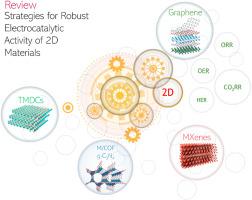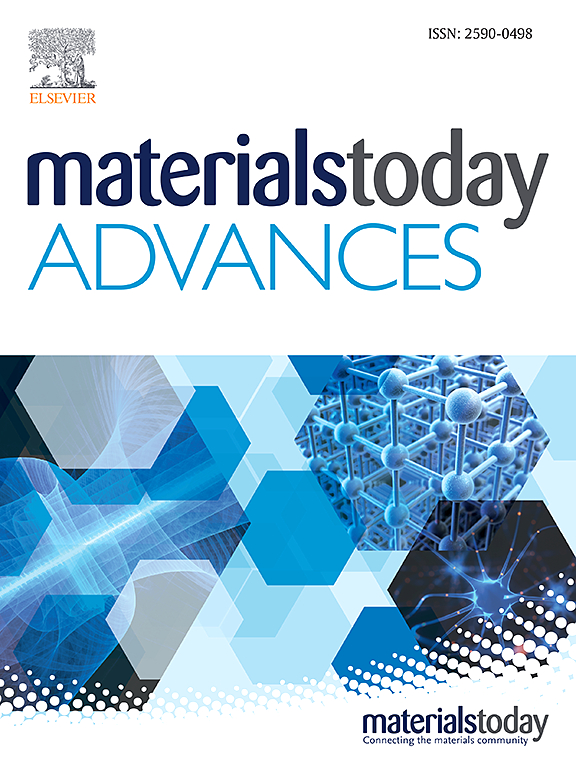增强二维材料电催化活性的策略:ORR、OER、HER 和 CO2RR
IF 8
2区 材料科学
Q1 MATERIALS SCIENCE, MULTIDISCIPLINARY
引用次数: 0
摘要
利用二维材料进行电催化是推进可持续能源转换技术的一种令人鼓舞的方法。本综述探讨了二维材料在关键反应(即 OER、HER 和 CORR)中实现强大电催化活性的策略。二维材料独特的结构和电学特性为实现快速催化性能提供了机会,并显示出显著的能源效率和选择性。我们系统地讨论了影响二维材料电催化效率的因素,包括其固有特性、表面改性技术、异质结构工程以及缺陷的作用。此外,我们还总结了为了解二维材料催化行为的基本机制而进行的实验和理论研究的最新进展。对于 HER、OER 和 ORR,我们探索了缺陷工程、相工程、界面工程和杂原子掺杂技术。此外,还研究了 CORR 的表面改性、表面结构调整以及电解质和电解槽优化策略。本综述强调了二维材料作为能源转换过程中高效、可持续的电催化剂的前景。此外,它还提供了对这一快速发展领域的未来见解,并强调了可能面临的挑战。总之,本综述旨在为寻求利用二维材料的潜在反应进行可持续能源转换应用的研究人员提供重要资源。本文章由计算机程序翻译,如有差异,请以英文原文为准。

Strategies for robust electrocatalytic activity of 2D materials: ORR, OER, HER, and CO2RR
Electrocatalysis utilizing 2D materials is an encouraging approach for advancing sustainable energy conversion technologies. This review explores the strategies employed to achieve robust electrocatalytic activity of 2D materials in key reactions, namely, the OER, HER, and CORR. The distinct structural and electrical characteristics of 2D materials offer opportunities for rapid catalytic performance, indicating significant energy efficiency and selectivity. We systematically discuss the factors governing the electrocatalytic efficiency of two-dimensional materials, including their intrinsic properties, surface modification techniques, heterostructure engineering, and the role of defects. Furthermore, we summarize the recent advances in experimental and theoretical studies to understand the fundamental mechanisms of 2D materials with respect to their catalytic behavior. For the HER, OER, and ORR, defect engineering, phase engineering, interface engineering, and heteroatom doping techniques have been explored. In addition, in the case of the CORR, surface modification, surface-structure tuning, and electrolyte and electrolyzer optimization strategies were examined. This review emphasizes prospective two-dimensional materials as efficient and sustainable electrocatalysts for energy conversion processes. Moreover, it provides future insights into this rapidly evolving field and highlights the possible challenges. In conclusion, it aims to serve as a remarkable resource for researchers seeking to harness the potential response of two-dimensional materials for sustainable energy conversion applications.
求助全文
通过发布文献求助,成功后即可免费获取论文全文。
去求助
来源期刊

Materials Today Advances
MATERIALS SCIENCE, MULTIDISCIPLINARY-
CiteScore
14.30
自引率
2.00%
发文量
116
审稿时长
32 days
期刊介绍:
Materials Today Advances is a multi-disciplinary, open access journal that aims to connect different communities within materials science. It covers all aspects of materials science and related disciplines, including fundamental and applied research. The focus is on studies with broad impact that can cross traditional subject boundaries. The journal welcomes the submissions of articles at the forefront of materials science, advancing the field. It is part of the Materials Today family and offers authors rigorous peer review, rapid decisions, and high visibility.
 求助内容:
求助内容: 应助结果提醒方式:
应助结果提醒方式:


